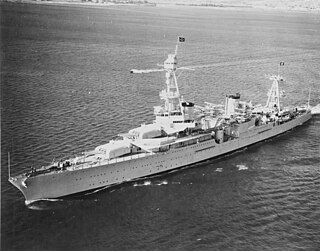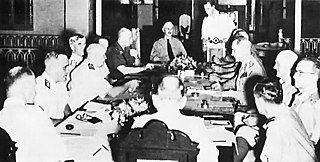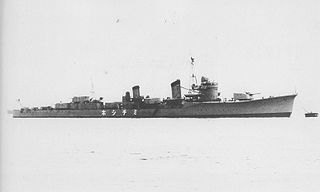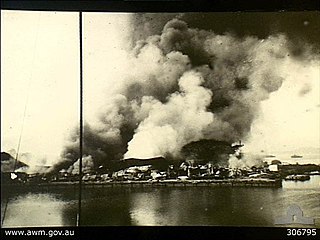
The United States Asiatic Fleet was a fleet of the United States Navy during much of the first half of the 20th century. Before World War II, the fleet patrolled the Philippine Islands. Much of the fleet was destroyed by the Japanese by February 1942, after which it was dissolved, and the remnants incorporated into the naval component of the South West Pacific Area command, which eventually became the Seventh Fleet.

USS Houston (CL/CA-30), was a Northampton-class cruiser of the United States Navy. She was the second Navy ship to bear the name "Houston".

Karel Willem Frederik Marie Doorman was a Dutch naval officer who during World War II commanded remnants of the short-lived American-British-Dutch-Australian Command naval strike forces in the Battle of the Java Sea. He was killed in action when his flagship HNLMS De Ruyter was torpedoed during the battle, having chosen to go down with the ship.

HNLMS De Ruyter was a light cruiser of the Royal Netherlands Navy. She was originally designed as a 5,000 long tons (5,100 t) ship with a lighter armament due to financial problems and the pacifist movement. Later in the design stage, an extra gun turret was added and the armor was improved. She was the seventh ship of the Dutch Navy to be named after Admiral Michiel Adriaenszoon de Ruyter.

HNLMS Tromp was the lead ship of the Tromp-class destroyer leaders built for the Royal Netherlands Navy. Built just prior to World War II, the ship served mainly in the Pacific and Indian Oceans against the Japanese, being based out of Sydney, Fremantle and Trincomalee where she served alongside British, Australian and US warships. After the war, she returned to the Netherlands; after 1949,Tromp was used as a training and accommodation ship, before being decommissioned in 1955, and scrapped in 1969.

The American-British-Dutch-Australian (ABDA) Command, or ABDACOM, was the short-lived supreme command for all Allied forces in South East Asia in early 1942, during the Pacific War in World War II. The command consisted of the forces of Australia, the Netherlands, United Kingdom and the United States. The main objective of the command, led by General Sir Archibald Wavell, was to maintain control of the "Malay Barrier", a notional line running down the Malay Peninsula, through Singapore and the southernmost islands of the Dutch East Indies. ABDACOM was also known in British military circles as the "South West Pacific Command", although it should not be confused with the later South West Pacific Area command.

The Battle of Sunda Strait was a naval battle which occurred during World War II in the Sunda Strait between the islands of Java, and Sumatra. On the night of 28 February – 1 March 1942, the Australian light cruiser HMAS Perth, American heavy cruiser USS Houston, and Dutch destroyer HNLMS Evertsen faced a major Imperial Japanese Navy (IJN) task force. After a fierce battle lasting several hours, all Allied ships were sunk. Five Japanese ships were sunk, three of them by friendly fire.

The Battle of Makassar Strait, also known as the Action of Madura Strait, the Action North of Lombok Strait and the Battle of the Flores Sea, was a naval battle of the Pacific theater of World War II. An American-British-Dutch-Australian (ABDA) fleet—under Schout-bij-nacht Karel Doorman—was on its way to intercept a Japanese invasion convoy reported as bound for Surabaya, when it was attacked by 36 Mitsubishi G4M1 "Betty" and 24 Mitsubishi G3M2 "Nell" medium bombers, which forced the fleet to retreat.

USS Pillsbury (DD-227) was a Clemson-class destroyer of the United States Navy that served during World War II and the first of two ships named after John E. Pillsbury, a Rear Admiral in the United States Navy. She was sunk by Japanese cruisers, approximately 200 miles east of Christmas Island on or around 2 March 1942 with all hands, one of two major American surface warships lost in World War II with no survivors.

USS John D. Ford (DD-228/AG-119) was a Clemson-class destroyer in the United States Navy during World War II. She was named for Rear Admiral John Donaldson Ford.

Naka (那珂) was a Sendai-class light cruiser in the Imperial Japanese Navy (IJN), named after the Naka River in the Tochigi and Ibaraki prefectures of eastern Japan. Naka was the third vessel completed in the Sendai class of light cruisers, and like other vessels of her class, she was intended for use as the flagship of a destroyer flotilla.

Ōshio was the second of ten Asashio-class destroyers built for the Imperial Japanese Navy in the mid-1930s under the Circle Two Supplementary Naval Expansion Program.

Michishio was the third of ten Asashio-class destroyers built for the Imperial Japanese Navy in the mid-1930s under the Circle Two Supplementary Naval Expansion Program.

Asashio was the lead ship of the ten Asashio-class destroyers built for the Imperial Japanese Navy in the mid-1930s under the Circle Two Program.

The Battle of Palembang was a battle of the Pacific theatre of World War II. It occurred near Palembang, on Sumatra, on 13–15 February 1942. The Royal Dutch Shell oil refineries at nearby Plaju were the major objectives for the Empire of Japan in the Pacific War, because of an oil embargo imposed on Japan by the United States, the Netherlands, and the United Kingdom after the Japanese invaded China and committed massive atrocities such as the rape of Nanking. With the area's abundant fuel supply and airfield, Palembang offered significant potential as a military base to both the Allies and the Japanese.

HNLMS Witte de With was an Admiralen-class destroyer, named after the 17th-century Dutch admiral of the same name. She served during World War II.

The Invasion of Sumatra was the assault by Imperial Japanese forces on the Dutch East Indies that took place from 14 February to 28 March 1942. The invasion was part of the Pacific War in South-East Asia during World War II and led to the capture of the island. The invasion of Sumatra was planned to occur prior to the invasion of Java to destroy the west flank of the allies and to give access to Java.

HNLMS Piet Hein was an Admiralen-class destroyer of the Royal Netherlands Navy, named after 17th century Dutch Admiral Piet Pieterszoon Hein.

HNLMS Java was a Java-class cruiser of the Royal Netherlands Navy. She was sunk during the Battle of the Java Sea on 27 February 1942.




















